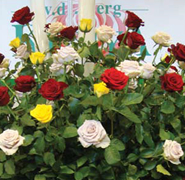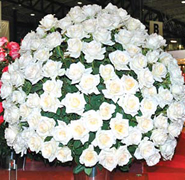Floriculture is an old traditional production with roots in ancient times. Starting from the XVII century, famous authors have written technical books, which show the
Category: Featured Articles (Jan – Feb 2015)
Union fleurs and the kenya flower council welcome the EU’s timely efforts to fasttrack Kenya’s reinstatement on duty-free status for its exports to the EU
Oserian Development Company a member of the Kenya Flower Council won the most Innovative African Producer for 2014 award in recognition of their sustainable developments
Focuses on Sustainability and Market Access Through a National Mechanism for Compliance Kenya Flower Industry focuses on sustainability and market access through a national mechanism
Understanding Marketing Research Fundamentals Businesses should develop marketing campaigns according to an overarching marketing strategy. Initially, this may not have been a major issue for
Many consumers don’t realise is how extremely complicated and complex the process of successfully bringing flowers from field to retail shelves is. Some of the
 On November 12th, the official kick-off of project SMART in Rwanda was launched. The kick-off of this project is part of the economic mission to Rwanda, led by Dutch Minister for Foreign Trade and Development Cooperation, Minister Ploumen. The aim of this project is to enable farmers in Rwanda to develop a sustainable and profitable business where productivity and food-safety are key. By combining Dutch technology and expertise with local expertise of farmers and knowledge of institutes, both parties see a clear win-win-situation.
On November 12th, the official kick-off of project SMART in Rwanda was launched. The kick-off of this project is part of the economic mission to Rwanda, led by Dutch Minister for Foreign Trade and Development Cooperation, Minister Ploumen. The aim of this project is to enable farmers in Rwanda to develop a sustainable and profitable business where productivity and food-safety are key. By combining Dutch technology and expertise with local expertise of farmers and knowledge of institutes, both parties see a clear win-win-situation.
During the trade mission to Rwanda, Minister Ploumen stated the importance of the cooperation of Dutch suppliers, such as Bosman Van Zaal and Hoogendoorn with local entrepreneurs of small-scale farms in Rwanda. SMART has projects in South Africa and Rwanda, focusing on different types of technological solutions for as well large, mid as small-scale companies. Small-scale farm Rwanda Best is project partner in Rwanda. The project is cofinanced by the Dutch Ministry of Foreign Affairs. Project partners greenhouse constructor Bosman Van Zaal and automation supplier Hoogendoorn Growth Management will realize the greenhouse.
 Kenya’s European Union (EU) market share is about 38%
Kenya’s European Union (EU) market share is about 38%
Kenya’s flower industry is the oldest and largest in Africa contributing 1.29% of the national GDP. The sector has continued to record growth in volume and value of cut flowers exported every year. According to Kenya National Bureau of Statistics in 2013, the floriculture industry exported 124, 858 tons valued at Kshs 46.3 billion. It is estimated that over 500,000 people, including over 90,000 flower farm employees depend on the floriculture industry.
The main production areas are around Lake Naivasha, Mt. Kenya, Nairobi, Thika, Kiambu, Athi River, Kitale, Nakuru, Kericho, Nyandarua, Trans Nzoia, Uasin Gichu, Kajiado and Eastern Kenya.
Kenya is the lead exporter of rose cut flowers to the European Union (EU) with a market share of about 38%. In the United Kingdom, supermarkets are the main retail outlets. Other growing destinations include Japan, Russia and USA.
 Going by the investment trends of the last couple of years, one is left to ask this simple question. Is Kenya shifting to the auction like markets while moving away from the auctions?
Going by the investment trends of the last couple of years, one is left to ask this simple question. Is Kenya shifting to the auction like markets while moving away from the auctions?
The trend of investment in flower for both new investments and extension of existing farms has been 80% uplands and 20% lowlands. This means the target production is long stems and big head varieties. However, the market is slowly shifting from auction to the more lucrative (relative) wholesale. Statistics available show less than five farms are purely auction growing with most of the remaining farms doing 65% direct and 35% auction. So, which way Kenyan flowers?
Most of the growers have shifted to the wholesale markets, and some of them are doing retail markets for some customers who need the long stem big head varieties. In this trend, one is left asking himself, why are we shifting to these varieties? Is it because our traditional short stem and small head market is dwindling? Or is it because the other market is bigger and has less competition? The answer will be Yes and No. Why? We all need to agree that Ecuador has slowly encroached to our traditional markets and looking at their quality, the competition maybe stiffer.
 A marketing guy in a flower farm asked me the other day what the greatest marketing challenges facing flower business today were and whether I think these challenges are different than they have been historically. That’s a great question and I’ve pondered it for a while.
A marketing guy in a flower farm asked me the other day what the greatest marketing challenges facing flower business today were and whether I think these challenges are different than they have been historically. That’s a great question and I’ve pondered it for a while.
Ultimately, what I decided is that I really don’t think the challenges themselves are any different today than they have been historically and I think the same basic marketing principles apply today that have always applied.
So, what are the greatest marketing challenges facing flower business today and why are they really the same as they ever were? In my opinion, at a high level, the challenges are:
- Identifying the most viable target markets.
- Effectively positioning what you have to offer against the competition.
- Selecting the right communication channels to appeal to your identified market
